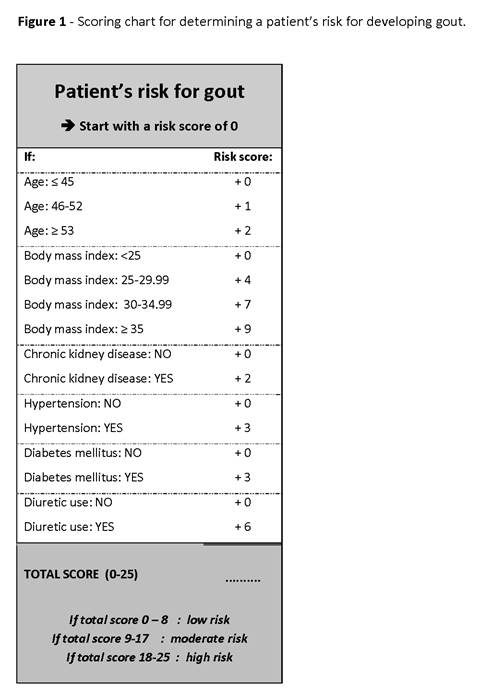Session Information
Session Type: Abstract Submissions (ACR)
Background/Purpose: The most common form of inflammatory arthritis observed in men is gout, a condition characterized by hyperuricemia and deposition of uric acid crystals in joints and surrounding tissues. It leads to unpredictable, severe attacks of acute joint inflammation, extreme pain, swelling, disability, and diminished physical and mental wellbeing. Gout affects millions of people and its prevalence is increasing. Hyperuricemia is considered a necessary, but insufficient, precursor of gout. Hence, additional risk factors have been identified, but collecting information on them all is too time-consuming. Therefore, this study aimed to develop an easy-to-use prediction tool for identifying patients with asymptomatic hyperuricemia at high risk for developing gout.
Methods: The tool was developed using data of 8,951 patients with uric acid levels >6 mg/dl from the Multiple Risk Factor Intervention Trial (MRFIT). The risk model was built using backward stepwise Cox regression analysis including 7 candidate variables and was externally validated in a nationally representative cross sectional sample from the US National Health and Nutrition Examination Survey (NHANES). Risk factors with a p-value <0.05 were retained and model accuracy was evaluated with receiver operating characteristic curve analyses by examining area under the curve (AUC) values. A simplified prediction tool was made for clinical convenience and to stratify patients into risk groups to discriminate between people at low, moderate and high risk of gout. Hazard and odds ratios were calculated for each risk stratum and logistic regression analyses were performed to determine the agreement between predicted and observed probabilities of having gout.
Results: 1,705 patients (19%) developed gout during the study. Gout patients reported more health complaints than non-gout patients, showing higher prevalence rates of chronic kidney disease, hypertension, and metabolic syndrome. They were also older and more likely to be obese, to smoke, and to use diuretics. Age, body mass index, chronic kidney disease, hypertension, diabetes, and diuretic use were all significant predictors for developing gout and were included in the final model (AUC value: 0.6420) which was externally validated on the NHANES data (AUC value: 0.7139). The resulting simplified prediction tool (Figure 1) discriminated well between patients from different risk strata. Hazard and odds ratios of the distinct strata showed increasing risks or odds on gout when moving from the lowest to the highest risk group and the agreement between observed and predicted probabilities of having gout was generally high.
Conclusion: The prediction tool is relevant for clinical practice since it helps physicians identifying asymptomatic hyperuricemia patients at high risk for developing gout.
Disclosure:
L. Siemons,
None;
E. Krishnan,
takeda,
2,
takeda,
5.
« Back to 2013 ACR/ARHP Annual Meeting
ACR Meeting Abstracts - https://acrabstracts.org/abstract/a-prediction-tool-for-incident-gout-among-those-with-hyperuricemia/

